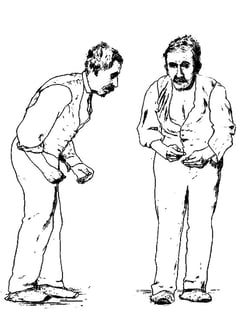Parkinson-Plus Syndrome: A Comprehensive Guide
Parkinson-Plus Syndrome is a group of neurodegenerative disorders that share similarities with Parkinson’s disease but have additional symptoms and a more aggressive progression. Unlike typical Parkinson’s, these conditions do not respond well to standard dopaminergic treatments, making diagnosis and management more challenging.
NEUROLOGY
Rishwin A R
2/14/20252 min read


What Is Parkinson-Plus Syndrome?
Parkinson-Plus Syndrome refers to a collection of disorders that resemble Parkinson’s disease but involve additional neurological impairments. These conditions include:
Multiple System Atrophy (MSA)
Progressive Supranuclear Palsy (PSP)
Corticobasal Degeneration (CBD)
Dementia with Lewy Bodies (DLB)
Each of these disorders has distinct features that set them apart from classic Parkinson’s disease.
Festinant Gait, in parkinson's disease
Causes and Risk Factors
The exact cause of Parkinson-Plus Syndromes remains unknown, but research suggests they involve abnormal protein accumulation in the brain, leading to neurodegeneration. Factors that may contribute include:
Genetic predisposition
Environmental toxins
Abnormal tau or alpha-synuclein protein buildup
Symptoms of Parkinson-Plus Syndrome
While symptoms vary depending on the specific condition, common signs include:
Motor Symptoms: Tremors, muscle rigidity, bradykinesia (slow movements), and postural instability
Cognitive Impairment: Memory loss, difficulty with problem-solving, and hallucinations (especially in DLB)
Autonomic Dysfunction: Blood pressure fluctuations, bladder issues, and temperature regulation problems (notable in MSA)
Speech and Swallowing Difficulties: Slurred speech and difficulty swallowing, leading to aspiration risks
Eye Movement Abnormalities: Seen in PSP, affecting the ability to look up and down


Micrographia and jagged handwriting, in parkinson's disease
Diagnosis
Diagnosing Parkinson-Plus Syndrome is complex and requires a combination of:
Clinical Evaluation: Neurological exams to assess motor and cognitive function
Imaging Tests: MRI or PET scans to rule out other conditions
DaTscan: A specialized scan to differentiate Parkinson’s from other movement disorders
Response to Medication: Lack of significant improvement with levodopa therapy suggests a Parkinson-Plus disorder
Types of Parkinson-Plus Syndromes
1. Multiple System Atrophy (MSA)
Affects multiple brain systems, leading to motor impairment and autonomic dysfunction
Symptoms: Tremors, low blood pressure, bladder issues, speech difficulties
Subtypes: MSA-P (Parkinsonian type) and MSA-C (Cerebellar type)
2. Progressive Supranuclear Palsy (PSP)
Characterized by difficulty with eye movements, balance issues, and cognitive decline
Symptoms: Stiff movements, frequent falls, personality changes
3. Corticobasal Degeneration (CBD)
A rare condition that affects movement, cognition, and sensory perception
Symptoms: Stiffness in one limb, involuntary movements, difficulty performing daily tasks
4. Dementia with Lewy Bodies (DLB)
A condition that overlaps with Parkinson’s and Alzheimer’s disease
Symptoms: Visual hallucinations, cognitive decline, Parkinsonian movement symptoms
Treatment and Management
There is no cure for Parkinson-Plus Syndrome, but treatments focus on symptom relief:
Medications: Levodopa (often with limited success), muscle relaxants, and medications for cognitive symptoms
Physical Therapy: Improves mobility, balance, and flexibility
Speech Therapy: Helps with swallowing difficulties and speech issues
Occupational Therapy: Assists with daily activities and adaptive strategies
Supportive Care: Nutrition guidance, assistive devices, and counseling
Prognosis
Parkinson-Plus Syndromes typically progress faster than Parkinson’s disease, with more severe disability over time. Life expectancy varies by subtype but often ranges from 6 to 15 years post-diagnosis. Early intervention and supportive care can improve quality of life.
FAQs
1. How is Parkinson-Plus different from Parkinson’s disease?
Parkinson-Plus conditions progress faster, have additional symptoms, and respond poorly to traditional Parkinson’s treatments.
2. Is Parkinson-Plus Syndrome hereditary?
Most cases are sporadic, but some genetic factors may play a role.
3. What is the most common type of Parkinson-Plus Syndrome?
Progressive Supranuclear Palsy (PSP) and Multiple System Atrophy (MSA) are among the most frequently diagnosed.
4. Can lifestyle changes help manage symptoms?
Yes, physical activity, speech therapy, and a healthy diet can help maintain function and improve quality of life.
5. Are there any new treatments on the horizon?
Research is ongoing into neuroprotective therapies and disease-modifying treatments, but currently, symptom management remains the primary approach.
Syndromes.xyz
Explore medical syndromes and their details here.
For Educational purposes only
The information on this site is not in any way, replacement for professional advice. Always consult your physician regarding personal queries
Connect
Support
syndromesxyz@gmail.com
© 2024. All rights reserved.
